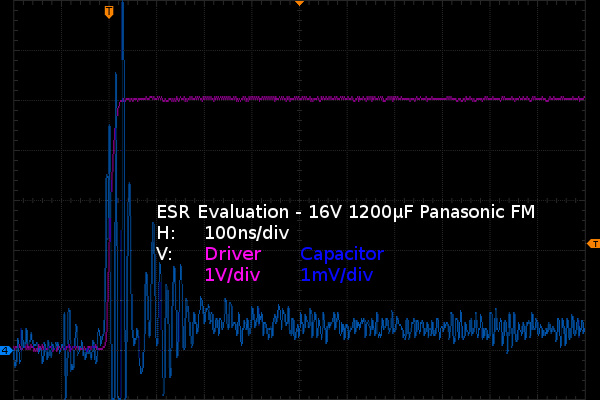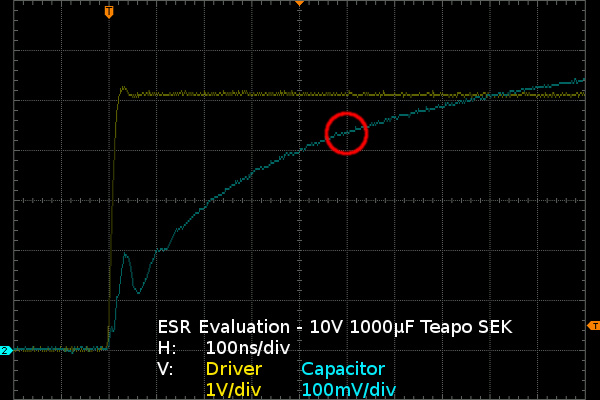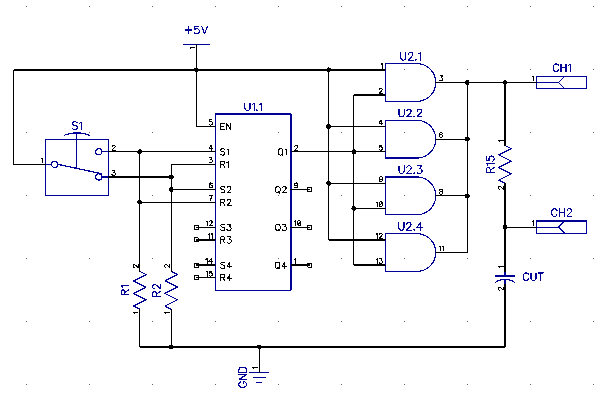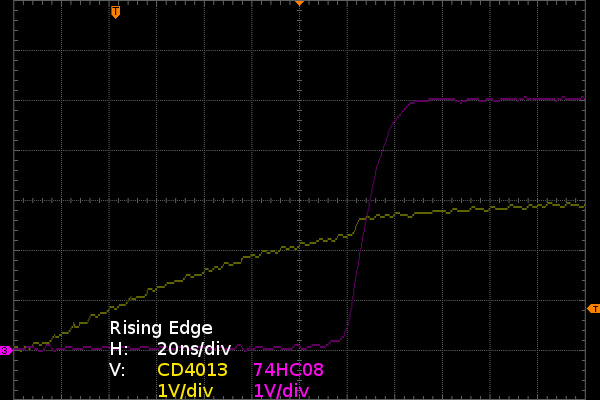Antec Aria AR300 PSU Repair
Have you ever bought a computer case with a proprietary PSU form factor? What do you do when it eventually wears out? One option is to repair it.
Interlude
What do the removed capacitors measure up to? I used my multimeter for capacitance and a simple debounced switch combined with my oscilloscope to estimate equivalent series resistance based on voltage at the 500 nanosecond mark from the step input. The result I get this way is a blended figure of ESR from DC to about 10MHz instead of ESR at a specific frequency.
If you were wondering what sort of rig I am using to measure ESR, the circuit I used in my SL300 repair was only an SPDT microswitch paired with a simple Set-Reset latch (CD4013) for debouncing running off 12V. After putting some more thought into it and not being satisfied with how lazy the CD4013's rising edge was, nor the way it drooped for several microseconds afterwards from driving about 6mA into the capacitor under test and resistors, I decided to improve it by adding a 74HC08 as a buffer and paralleling the outputs for lowered output impedance. Why use a 74HC08? Mainly because I happened to have some on-hand, but also because HC-series CMOS gates are able to drive their outputs within millivolts from either rail under light load, even at 5V.
How much improvement do I get out of buffering the 4013's output through the gates? With a 5V supply voltage, 1kΩ resistor and a 1200µF FM capacitor providing output loading, the CD4013 takes 240ns to rise to only 3V (60%) and becomes current-limited beyond that point (the chip has weak output drivers at 5V). With the AND gates acting as buffers, the test signal rises from 10% to 90% in 19ns and 0% to 100% in less than 40ns. Not bad for a $0.40 part and five-minute tweak.
In principle, voltage across an ideal 10µF capacitor with a 1kΩ charging resistor using a 5V source should be 250µV after 500ns, which can be considered negligible for my ESR evaluation purposes, since it is close to the noise floor of my test setup. With 5V across the 1kΩ resistor, the test current can be considered constant at 5mA for any remotely reasonable amount of ESR. Therefore, the ESR can be estimated as the voltage difference between initial turn-on and 500ns later divided by 5mA, which translates into 0.2Ω of ESR per millivolt. Using this approximation, we are talking about an approximation error in the order of 1% on 10Ω ESR, less for lower, more reasonable values of ESR. Since I am working with a noise floor of about 1mV, my ESR measurement resolution is limited to 0.2Ω while using this method. It's useless for measuring good caps but good enough to spot low-quality or significantly degraded ones. I could achieve better resolution by using a lower-value resistor, but then I would also need much stronger drivers than a 74HC08.


I am not going to post a full set of oscilloscope screen grabs this time around. However, here is a comparison of a fresh Panasonic 16V 1200µF FM as the good cap reference and the first 1000µF Teapo capacitor on the 5VSB output as the bad one. The Panasonic has a specified ESR of 0.018Ω and, as expected, my measurement attempt shows effectively no change in the noise level before and after the step since the ESR is an order of magnitude smaller than my measurement capability. Noise at turn-on is just parasitic inductance causing momentary oscillation due to extremely low ESR, while the 0.5mV bump afterward is caused by wiring resistance in my test rig and is the same with my test leads shorted out. The Teapo, on the other hand, lost nearly 99% of its nominal capacitance and instead of its already passable 0.29Ω specified ESR for “general” applications, the 440mV rise implies an ESR in the neighborhood of 88Ω and the charge curve implies capacitance much worse than the 11µF reported by my meter. In any case, anything beyond 10Ω worth of ESR is already so far gone that worrying about accuracy is like beating a dead and buried horse.
So, how did they fare?
| Capacitor | Measured Value | Estimated ESR |
|---|---|---|
| Teapo SEK 50V 22µF (photocoupler output filter) | 333nF | 1128Ω |
| Teapo SEK 50V 100µF (auxiliary supply filter capacitor) | 43µF | 35Ω |
| Teapo SEK 10V 1000µF(first 5VSB output filter cap) | 11µF | 88Ω |
| Teapo SEK 10V 1000µF (second 5VSB output filter cap) | 79µF | 7.2Ω |
| Fuhjyyu TNR 10V 2200µF (first 5V output filter cap) | 31µF | 2.4Ω |
| Fuhjyyu TNR 10V 2200µF (second 5V output filter cap) | 59µF | 1.8Ω |
| Teapo SEK 16V 1000µF (12V output filter cap) | 990µF | Less than 0.2Ω |
| Teapo SC 10V 3300µF (first 3.3V output filter cap) | 3250µF | Less than 0.2Ω |
| Fuhjyyu TMR 10V 4700µF (second 3.3V output filter cap) | 3040µF | 1.4Ω |
| Panasonic FM 16V 1200µF (just because I have a bag of them) | 1199µF | Less than 0.1Ω |
As predicted, all capacitors connected to the standby/auxiliary transformer are well and thoroughly thrashed, especially the 22µF cap that used to be next to ZD4. I am surprised to see there are still two seemingly serviceable capacitors on the main output rails, and even more surprised that one of them happens to be the general-purpose Teapo SEK on the 12V rail.
Get Tom's Hardware's best news and in-depth reviews, straight to your inbox.
Why does the FM get a result of “Less than 0.1Ω?” Because I fiddled with my test circuit some more after I finished the repair to find out how much I could lower the test resistor before seeing significant droop on the HC's output. By halving my test resistor, I double the test current and double the ESR sensitivity to a much more useful 0.1Ω/mV.
-
iam2thecrowe That was a good read. I have a lot of custom power supplies (not PC atx) that i would like to fix at work instead of replace, would be a lot cheaper (there's some high wattage power supplies that cost $5000 to replace). Need to convince the boss to buy a good oscilloscope.Reply -
Rookie_MIB I have several of those cases - they make nice little machines for office use but the PSUs tend to flake. I've had to replace several...Reply -
Daniel Sauvageau All the standby power supplies I remember looking at are of the good old flyback design and one particularity of the flyback topology is that it has the worst ripple current on the output capacitors of all converter topologies or in other words: it is the harshest on output capacitors. Until I saw the waveforms while poking around the SL300, one little yet important detail skipped my mind: the harsh current waveform behavior applies to ALL outputs.Reply
Any flyback supply with sub-par output capacitors on any of its outputs will inevitably fail in relatively short order.
After that 'oops' moment, I decided to pop the lid on my LG 204WT which I thought had dying CCFL tubes, popped three of its auxiliary supply capacitors off the board, measured them at 5-20 ohms of ESR, replaced them, no more flicker or random turn-on issues. -
gnyff I love it when stuff is repaired! It's so sad that almost every consumer device today is made to fail and be replaced. Even in the cases where the designer did not specifically design for failure most commonly it's definitely not cost-effective for the user to have it repaired. :-(Reply
Anyways, I've also replaced one of those lousy non-standard PSU. Hard to find and depressingly expensive. Thus, I am avoiding non-standard parts as much as possible now! ;-)
By the way, in one of my systems the standby power was around 12W (!) even after shutting off 5VSB functions (wake on LAN, keyboard etc) in the BIOS. I did on bother to investigate further (thinking "lousy supply"!) and simply added a proper "full off" power switch. Probably other owners should think of doing the same ;-) -
Rookie_MIB Reply16509494 said:Anyways, I've also replaced one of those lousy non-standard PSU. Hard to find and depressingly expensive. Thus, I am avoiding non-standard parts as much as possible now! ;-)
By the way, in one of my systems the standby power was around 12W (!) even after shutting off 5VSB functions (wake on LAN, keyboard etc) in the BIOS. I did on bother to investigate further (thinking "lousy supply"!) and simply added a proper "full off" power switch. Probably other owners should think of doing the same ;-)
I wonder if a SFX PSU could be mounted in those cases. Might be a viable solution... -
nukemaster Another great one!Reply
I actually was interested in that case back when it was released, but just kept rocking the Sonata and Sonata II. While my power supplies did not fail. caps leaked after a while(power supplies still worked)and I took the power supplies out of service forever.
Rookie_MIB,
SFX would be an interesting idea to see for sure. My SFX is still going after 5 years of 24/7 operation(not bad for a case included 300 watt unit). -
Daniel Sauvageau Reply
The dimensions might fit but mounting holes would be on the wrong side (for mounting in a way that might fit internally) and the IEC socket would face either the motherboard or the top cover. Nothing some drill-and-tapping with some wire splicing cannot fix for people who would favor this route instead of a repair of the existing unit where that is possible.16509868 said:I wonder if a SFX PSU could be mounted in those cases. Might be a viable solution...
BTW, the total repair cost for the 5VSB side is about $1.50 for the caps and resistor. The rest is basically free since I scavenged the SCs from a dead (catastrophic primary-side failure) PSU and would have cost around $2.50 otherwise. If Asus had specified higher quality parts from Channel Well though, the PSU may have cost less than $0.50 extra to get right on the first try. Evem doing as little as specifying Teapo SC as the minimum requirement would have easily doubled the trouble-free service life over using SEK..
It always bugs me when only a few pennies worth in parts and materials can spell the difference between a product that might only last 2-3 years and a product that should easily last 10+ years. -
nukemaster That small cost per unit adds up.Reply
I can not count the number of times I say, gee a xx cent part would have solved this damn issue and yet no one does it.
Drilling and making it fit is no issue. :)
I still get my small system fix with an SG05 case.
Where do you get your parts from? Digikey is not too expensive, but many times the shipping cost more than the parts(especially with resistors that are cheap to begin with.). -
Daniel Sauvageau Reply
The "small cost" may add up but if you charge $1 to put the $0.50 worth of better quality parts in, you still make a 100% profit on that extra cost and you score points in the quality/reliability column. For the most part, those better quality parts are the same physical size, so no fitting or PCB layout concerns there.16511613 said:That small cost per unit adds up.
Where do you get your parts from? Digikey is not too expensive, but many times the shipping cost more than the parts(especially with resistors that are cheap to begin with.).
As for where I get my parts, they are mostly Digikey. I either lump my order with parts I need to repair something for someone else (and pass the shipping cost to them) or build my order for multiple non-urgent projects until it qualifies for free shipping.
Edit: and for things like 0805 resistors and capacitors, I usually order in cut-tapes of 100 since we're still only talking $1-2 there. If I had more storage space, I would order whole reels for $10-15 (2000-3000 units) and likely never have to worry about ordering more of that resistor or capacitor value (for personal use) for the rest of my life. -
pjmelect I often repair computer power supplies and I enjoyed reading this article. One comment, that may help others and may explain some things in the article such as the power reduction of the fixed power supply.Reply
Capacitors with high ESR always have a very high leakage current near their rated voltage. The leakage current at low multi-meter voltage levels is not normally measurable, but increasing the voltage across the capacitor dramatically increases the leakage. Circuits with capacitors with high ESR in them normally fail not due to the ESR or the reduction of capacitance, but due to the high leakage current. If you do not have a ESR meter you can simply put a suspect capacitor across a power supply at its rated voltage and check the leakage current. A high leakage current is a good indication of a high ESR value.
I use a in-circuit ESR meter to test all of the electrolytic capacitors (even the small ones) before I even start trying to fault find a power supply.

